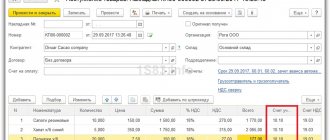Hello. In this article we will talk about what markdown is and why it is necessary.
Today you will learn:
- For what purpose do they use markdowns?
- How is the markdown procedure carried out?
- What is accounting and tax accounting for markdown of commercial products.
What is product markdown
When visiting any large store, you can see counters on which discounted products are placed. But what does markdown mean?
It is necessary to take into account that markdown of goods is a procedure in which the cost of commercial products is reduced.
At the same time, buyers are fully confident that this is a completely simple procedure for the manufacturer. But what could be simpler than reducing the cost?
In fact, not everything is as simple as it seems from the buyer’s side. Markdown is a complex procedure that requires documentation taking into account generally accepted requirements.
It turns out that the manufacturer simply cannot change the price of commercial products, since it is necessary to follow a special markdown procedure.
What is a markdown
A markdown is usually called a reduction in the purchase price of a product that has been received or has been on sale for some time in order to facilitate its sale.
It is advisable to carry out such a procedure if one or more factors are present:
- the product is not in great demand;
- the products are stored in a warehouse or on store shelves;
- the product went on sale with damage (to the item itself or its packaging);
- the presentation is lost;
- consumer properties are partially lost;
- obsolescence of the item for sale;
- market fluctuations that affected demand, etc.
Both parties benefit from the discount:
- the buyer gets the opportunity to spend less money on the purchase;
- the seller sells the goods, thereby increasing his turnover.
When is a product marked down?
You cannot simply reduce the price of a product, since there are a number of reasons for this.
Let's note the most common ones:
- When demand decreases;
- Obsolescence of commercial products;
- When market value decreases;
- Partial loss of presentation;
- Expiration date.
In practice, the store reduces the price of the product only if the expiration date expires. To attract the buyer, he places the product in the center of the hall on a special counter. At the same time, a special bright price tag is made, which is sure to attract the buyer’s attention and he will pay attention to the discounted product.
Well, don’t forget about well-known promotions, when in the center of the trading floor a representative of a store or shopping center offers to purchase one product and get a second one at a reduced cost.
Few people think that a product at a reduced cost is a discounted product that sells beautifully. Buyers can, even without paying attention to expiration dates and appearance, “sweep” products off the shelf.
As for the partial loss of presentation, in most cases this is torn packaging. This often happens when loading and unloading goods.
It should be taken into account that both sales representatives and non-trade organizations can carry out markdowns. The main mission of cost reduction is to sell goods at a reduced price in order to make a profit and reduce costs.
As a result of this procedure, goods are sometimes sold at a price lower than the purchase price.
Markdown in accounting
New prices for goods can be reflected in accounting in different ways: it all depends on the method of valuing goods adopted in the policy of a particular retail outlet.
Accounting for goods at their acquisition prices (purchase prices)
This accounting method is used by both retail outlets and wholesale organizations.
- If the price of a product is reduced by an amount within the trading margin , there is no need to reflect this in accounting at all.
FOR EXAMPLE. The Home Everything store purchased the 10th batch of tablecloths (25 pieces) at a price of 200 rubles. per piece, putting them on sale for 350 rubles. (VAT included). 20 tablecloths were sold at this price, the rest were left in the store. Based on the results of the inventory, it was decided to discount the tablecloths by putting a price tag of 300 rubles on them. 3 more tablecloths were sold. What should the store accountant write down in the journal entries? Entries will vary in time.
In the month of delivery of a batch of tablecloths:
- debit 41, credit 60 – 5,000 rub. (25 pcs. x 200 rub.) – posting of a batch of tablecloths;
- debit 50, credit 90, subaccount “Revenue” – 7,000 rubles. (350 rub. x 20 pcs.) – proceeds from the sale of tablecloths;
- debit 90, subaccount “Cost of sales”, credit 41 – 4,000 rubles. (200 rub. x 20 pcs.) – write-off of the cost of tablecloths sold;
- debit 90 subaccount “VAT”, credit 68 subaccount “Calculations for VAT” - accrual of VAT on goods sold.
In the month of sale of discounted tablecloths:
- debit 50, credit 90, subaccount “Revenue” – 900 rubles. (300 rub. x 3 pcs.) - reflection of revenue from the sale of tablecloths at a new price;
- debit 90 subaccount “Cost of sales”, credit 41 – 600 rub. (200 rub. x 3 pcs.) – write-off of the purchase price of sold tablecloths;
- debit 90 subaccount “VAT”, credit 68 subaccount “Calculations for VAT” - accrual of VAT on goods sold.
- If the amount of the markdown is greater than the trade margin , you cannot change the original discount prices, otherwise you will end up selling at a loss. In this case, the company must have a special reserve for markdowns, which is reflected in accounting as follows: debit 91 subaccount “Other expenses”, credit 14 - creating a reserve for reducing the cost of goods.
ATTENTION! This reserve is created for each unit of inventory according to accounting.
Then amounts from the reserve are written off as goods are sold: debit 14, credit 91 “Other expenses”.
The procedure for marking down goods
If you need to mark down an item, do not worry, as this is a simple procedure that requires attention and adherence to generally accepted rules.
Let's look at how to properly reduce the cost of a necessary product:
- Drawing up an order.
Before starting the cost reduction procedure, it is necessary to prepare a document that establishes the requirements and features of a specific markdown. In practice, the manager is obliged to prepare an order and convey it to employees, who only after this can take a number of measures aimed at reducing the price of a particular product.
Also, do not forget that according to the order, a material person is established who will be responsible for the entire markdown procedure. Such an employee must not only familiarize himself with the order, but also receive it with his personal signature.
- Inventory.
This is the very first and, perhaps, main thing to start with. You must clearly understand how many units of products are in the warehouse and in the shopping center.
Be prepared to draw up a special act in which you need to indicate:
- Name of product;
- Total amount;
- Article number of each product;
- Characteristics;
- Reason for markdown.
At the end of the document, you should summarize the results according to which you can understand how many units of product and for what reason need to be sold as quickly as possible at a reduced cost.
- Determination of market value.
Before marking down goods, it is necessary to determine the real cost of each unit of production. It’s worth noting right away that the procedure for determining market value is not regulated in any way. If you have a large company, it is also worth considering that this is not the responsibility of an accountant.
To determine the market value, a special commission is created, which includes:
- Experts in the quality of this type of product;
- Sales specialists;
- Company employees who can inspect the goods and estimate the possible cost of its sale.
All results of the work are recorded in a special act in the form MX-15. A document of this form can be easily found on the World Wide Web.
Procedure for revaluation of inventories
For revaluation you need:
- decision (order, instruction) of the director;
- inventory - based on its results, an inventory list-act is drawn up (instruction of the USSR Ministry of Finance No. 75 and the USSR State Committee for Prices No. 10-17/1500-25 dated 05/05/1986);
How to conduct an inventory and reflect it in accounting, read the articles:
- “Inventory of inventories”;
- “Reflection of inventory results in accounting.”
What nuances need to be taken into account when drawing up an accounting policy, read the article “PBU 1/2008 “Accounting Policy of an Organization” (nuances).”
MIR LLC is an organization engaged in the sale of televisions.
In its sales area, MIR LLC displays samples of the goods it sells. Additional costs appear (installation costs, installation costs, etc.), which increase the cost of the goods on display.
MIR LLC takes these goods into account. 41, but the storage location is indicated not as a warehouse, but as a sales area.
As a result of using the product in the hall, its original qualities will most likely be lost. In accounting, a reserve is recognized for reducing the value of inventories.
Dt 44 Kt 60 (76) - expenses (installation, etc.).
Dt 19 Kt 60 (76) - VAT on expenses is taken into account.
Dt 68 Kt 19 - VAT is accepted for deduction.
Dt 91.2 Kt 14 - a reserve created for the depreciation of the value of goods in the hall.
Dt 14 Kt 91.1 - when selling or otherwise disposing of goods, the created reserve is included in the financial result.
Zvezda LLC purchased materials at the beginning of the year. The accountant reflected them on the account. 10. At the end of the year, before balancing the balance, an inventory was carried out. As a result, it was revealed that the TRS decreased, and the director decided to create a reserve for the difference between the purchase price and the TRS.
In the annual balance sheet, the cost of materials will be reflected minus the reserve.
Let’s assume that in the next reporting period the TPC has increased, then we need to again calculate the difference between the purchase price of materials and the TPC. But in this case, we subtract the second year reserve from the first year’s reserve and make a posting for this amount Dt 14 Kt 91.1.
In the balance sheet, the cost of materials will be taken into account as the difference between the purchase amount and the amount remaining on Kt 14.
If in the future the selling price of unused materials increases, the accountant has the right to overestimate them, but not higher than the original value, since overestimation of the value of current assets is not allowed.
In tax accounting, we do not have the opportunity to create such reserves. But we can take into account the costs of markdowns in advertising costs (non-standardized), for example. This must satisfy the requirements of paragraph 1 of Art. 252 of the Tax Code of the Russian Federation (clause 4 of Article 264 of the Tax Code of the Russian Federation).
What is a markdown act
A markdown act is a document that records a reduction in the price of commercial products for various reasons.
The approved form contains three pages.
The first is the title page. In this case, you will need to fully indicate the name of the organization and indicate the reason as a result of which the decision was made to sell products at a reduced cost. The main thing is to leave a column on the title page for approval of the markdown act by the head of the company.
On the second and third pages you will need to indicate the characteristics of the product.
Be prepared to note:
- Markdown percentage;
- Cost before and after markdown;
- Difference in cost;
- Reason for cost reduction.
You will also need to provide a detailed description of the appearance of the product. The document is drawn up exclusively in the presence of the assembled commission. Once completed, everyone must sign the completed document.
Accounting for revaluation of goods
Revaluation of goods can be carried out for various reasons: due to changes in demand for goods, seasonal sales, the approaching end of the sales period, loss of original qualities, etc.
Revaluation can be in the direction of lower prices (discount) and in the direction of increasing prices (revaluation). In all cases of price changes, there must be a corresponding document for the revaluation of goods (order, instruction, etc.) signed by the head of the organization.
The procedure for revaluation and the recording of its results depend on the prices at which goods are recorded.
The procedure for drawing up a markdown act on goods
The markdown act is the main document that must be drawn up correctly. Let's consider what needs to be taken into account when drawing up the document.
It is worth taking into account that the document is drawn up in two copies.
You will need to attach an inventory document to the first act and submit it to the accounting department.
The second copy of the document remains in the hands of the financially responsible person who is entrusted with the responsibility for carrying out this procedure.
Particular attention should be paid to filling out sections of the act.
In addition to the product data, you will need to indicate:
- Full name of the organization;
- Legal and actual address;
- Full details.
Only after all the documentation will be compiled and marked down.
Employees of the sales floor can change the price tags for discounted goods and offer customers to purchase them at a reduced cost. On the contrary, it is absolutely forbidden to do so!
What does the Law say about markdowns?
There are no strictly accepted norms for discounting goods. It is important that the Discount Regulations adopted in a particular trading organization do not contradict accounting standards and relevant government requirements:
- Federal Law of November 21, 1996 No. 129-FZ “On Accounting”;
- Order of the Ministry of Finance of the Russian Federation dated July 29, 1998 No. 34n “On approval of the Regulations on maintaining accounting records and financial statements in the Russian Federation”;
- The accounting plan, in particular, the contents of the “Inventories” account;
- Order of the Ministry of Finance of Russia dated June 13, 1995 No. 49 “On approval of the Guidelines for the inventory of property and financial obligations”;
- Letters from the State Statistics Committee approving document forms when conducting an inventory;
- Letter of Roskomtorg dated July 10, 1996 No. 1-794/32-5, which approved the Methodological Recommendations for accounting and registration of operations for the receipt, storage and release of goods in trade organizations.
Tax accounting
Income tax.
The taxpayer, by his own decision, carried out a depreciation (revaluation) of assets and reflected its amount in accounting.
The amount of such a markdown (revaluation) does not change
the book value of assets and does not affect income or expenses associated with the acquisition of these assets (clause 152.10 of the Tax Code, hereinafter referred to as the Tax Code).
VAT.
When supplying goods and services, the VAT tax base is their contractual value (clause 188.1 of the Tax Code). And if this is a controlled operation, then the cost is not lower than the regular price (Article 39 of the Tax Code). A tax credit is formed in a similar way - based on the contractual value, but not higher than the regular price in the case of a controlled transaction. The main condition for including accrued or paid VAT amounts in the tax credit is the use of inventories in taxable transactions within the framework of business activities (clause 198.3 of the Tax Code).
Clause 198.5 of the Tax Code lists events that require the accrual of tax liabilities in order to “remove” a previously reflected tax credit. Inventory write-down is not listed among such events.
Thus, if the company continues to use discounted inventory in business activities, then the accountant does not need to reverse the tax credit
, reflected when purchasing or manufacturing these inventories.
Example 1
The company is engaged in the wholesale trade of women's clothing (accounting is kept in accordance with P(S)BU). In May 2013, we purchased a large batch of summer sundresses and began selling.
We provide information on the movement of goods in the table (periods when there were no sales are not indicated).
Movement of goods throughout the enterprise for the period May 2013 – March 2014
(UAH)
Printable table available on the page: https://uteka.ua/tables/1308-0
| Range | Acquisition, May 2013 | Implementation | Balance as of 03/31/14 | |||||||
| June – August 2013 | December 2013 | March 2014 | ||||||||
| Quantity, pcs. | Price for 1 piece. VAT included | Quantity, pcs. | Price for 1 piece. VAT included | Quantity, pcs. | Price for 1 piece. VAT included | Quantity, pcs. | Price for 1 piece. VAT included | Quantity, pcs. | Price for 1 piece. VAT included | |
| 1 | 2 | 3 | 4 | 5 | 6 | 7 | 8 | 9 | 10 | 11 |
| Model A | 1 000 | 456 | 820 | 612 | 155 | 360 | 25 | 480 | 0 | 0 |
| Model B | 1 000 | 552 | 605 | 738 | 257 | 432 | 80 | 576 | 58 | 552 |
As we can see from the table, in December 2013 the company sold sundresses at a price below cost (column 7
Accounting and tax accounting of transactions with goods
(UAH)
Printable table available on the page: https://uteka.ua/tables/1308-1
| No. | Contents of operation | Source documents | Accounting | Tax accounting | |||
| Dt | CT | Sum | Income | Expenses | |||
| 1 | 2 | 3 | 4 | 5 | 6 | 7 | 8 |
| 1 | Product purchased from supplier (1,000 pcs. x 380 + 1,000 pcs. x 460) | Invoice for issue of goods and materials | 281 | 631 | 840 000 | – | – |
| 2 | VAT credit reflected | Tax invoice | 641 | 631 | 168 000 | – | – |
| 3 | Settlements have been made with the supplier | Bank statement | 631 | 311 | 1 008 000 | – | – |
| 4 | Product sold in 2013 (820 pcs x 612 + 605 pcs x 738 + + 155 pcs x 360 + 257 pcs x 432) | Invoice for issue of goods and materials | 361 | 702 | 1 115 154 | 929 295 | – |
| 5 | Tax liabilities for VAT accrued | Tax invoice | 702 | 641 | 185 859 | – | – |
| 6 | Revenue received from sales | Bank statement | 311 | 361 | 1 115 154 | – | – |
| 7 | Cost of goods sold written off [(820 pcs. + 155 pcs.) x 380 + + (605 pcs. + 257 pcs.) x 460] | Standard form invoice No. M-11* | 902 | 281 | 767 020 | – | 767 020 |
| 8 | The markdown of goods is reflected as of December 31, 2013: [(380 UAH – 300) x (1,000 pcs. – – 820 pcs. – 155 pcs.) + (460 – 360) x x (1,000 – 605 – 257)] | Markdown certificate** | 946 | 281/R | 15 800 | – | – |
| 9 | Product sold in March 2013 (25 pcs x 480 + 80 pcs x 576) | Invoice for issue of goods and materials | 361 | 702 | 58 080 | 48 400 | – |
| 10 | Tax liabilities for VAT accrued | Tax invoice | 702 | 641 | 9 680 | – | – |
| 11 | Revenue received from sales | Bank statement | 311 | 361 | 58 080 | – | – |
| 12 | Write-off of markdown of goods sold [(25 pcs x 80) + (80 pcs x 100)] | Accounting information | 281/R | 281 | 10 000 | – | – |
| 13 | Cost of goods sold written off (25 pcs x 300 + 80 pcs x 360) | Standard form invoice No. M-11 | 902 | 281 | 36 300 | – | 46 300*** |
| 14 | The additional valuation of goods is reflected as of March 31, 2014. (58 pcs x 100) | Accounting information | 281/R | 719 | 5 800 | – | – |
* Approved by order of the Ministry of Statistics dated June 21, 1996 No. 193.** The form of the act is given in the appendix to the Regulations on the procedure for marking down and selling stale products from the group of consumer goods and industrial and technical products, approved by order of the Ministry of Economy and the Ministry of Finance dated September 10, 1996 No. 120/190. | |||||||
When is it necessary to mark down inventory?
When exactly are inventories recorded at net realizable value? Then, when at the balance sheet date their price has decreased or they are damaged, outdated or in some other way lost the initially expected economic benefit from their use (clause 25 P(S)BU 9).
How do you know if the cost has exceeded the net realizable value? The following events can be a signal:
- inventory is out of date or spoiled;
- the selling price has decreased;
- Expected costs to complete production and distribution have increased.
Let's say that in the next reporting period the company plans to sell inventory at a price below cost. Then, based on the principles of conservatism, prudence and objective assessment, the management of the enterprise must notify users of the financial statements about this. That is, when discounting inventories, the loss from the sale of discounted inventories is recognized as if in advance - even before the moment of sale of inventories, but on the balance sheet date.
Inventories as assets of an enterprise
Every housewife knows what supplies are. In a manufacturing enterprise, inventories are assets that:
- intended for consumption in the process of production, performance of work, provision of services, as well as for enterprise management (raw materials, basic and auxiliary materials, components, low-value and wearable items);
- are in work-in-progress (product manufacturing is in progress);
- are kept for sale (finished products, goods) (clause 4 P(S)BU 9 “Inventories”).
Purchased or self-produced inventories are accounted for at their original cost (clause 8 of P(S)BU 9). In this case, the initial cost of inventories will be:
- their cost (acquisition costs) - if they are purchased;
- their production cost, determined in accordance with P(S)BU 16 “Costs” (clause 10 P(S)BU 9) - if they are manufactured by the enterprise independently.
At the balance sheet date, inventories should be reflected in accounting and financial statements at the lowest
of two values: at cost or at net realizable value (clause 24 P(S)BU 9). Net realizable value is the expected selling price of inventories in the ordinary course of business less the expected costs of completing their production and selling them.
This is the so-called rule of least valuation.
Accounting
According to P(S)BU
Net realizable value is determined for each inventory item individually. Let us recall that according to clause 7 of P(S)BU 9, a unit of inventory is taken to be the name or a homogeneous group (type) of inventory.
The amount of write-down of the original cost to net realizable value is written off as other operating expenses (clause 27 P(S)BU 9; clause 5.8 of the Methodological Recommendations for Accounting for Inventories, approved by Order of the Ministry of Finance dated January 10, 2007 No. 2, hereinafter referred to as the Method Recommendations No. 2).
Net realizable value is re-estimated in each subsequent period.
What if the net realizable value of the discounted inventory increases in the future? Then other operating income arises (it can be reflected in the amount of no more than the amount of the previous markdown) (clause 28 P(S)BU 9).
Let's not forget that any business transaction is reflected in accounting on the basis of a primary document. In this case it is an act of markdown
(clause 3.15 Recommendation Method No. 2).
For the timely identification of “deposits” of reserves and their markdown, a Signal Certificate
on the deviation of the actual balance of materials from the established reserve standards can be used according to the standard form No. M-18, approved by Order of the Ministry of Statistics dated June 21, 1996 No. 193 (clause 4. 12 Method Recommendations No. 2).
Important point!
Information on the movement of inventories at the enterprise is reflected in the accounts of class 2 “Inventories”. But what will happen if we reflect the write-down of inventories by posting Dt 946 “Losses from impairment of inventories” - Kt 20, 22, 23, 26, 28? We will lose analytical data on markdown amounts for each specific inventory item. What if we then need to perform the opposite action - an additional valuation within the limits of the previously written off amounts? It will be almost impossible to do this without analytics.
Therefore, we recommend: in order to always have analytical data on discounted inventories, for each type (group) of inventories, create a counter-account “Reserve for impairment of inventories” to the main account (similar to sub-account 285 “Trade margin” for retail enterprises). In this case, the “Reserve for impairment of inventories” accounts are counter-accounts to the inventory accounts and are collapsed in the Balance Sheet.
For example, to reflect the markdown of finished products in warehouses as of the balance sheet date, you can open subaccount 261 (R) “Reserve for depreciation of finished products.”
According to IFRS
Accounting for inventories is governed by IAS 2 Inventories. The requirements here are the same as in the national standard, for example:
- the cost of purchased or manufactured inventories is formed from the costs associated with their acquisition, processing, and other expenses incurred during the delivery of inventories (§ 10);
- inventories are accounted for at cost or at net realizable value (the lesser amount is taken) (§ 9);
- the grounds for markdown (§ 28) are the same as in P(S)BU 9;
- the amount of inventory depreciation is included in expenses (§ 34).
However, there is also a difference from the Ukrainian standard
. According to § 33, 34 IAS 2, the amount of markdown is reversed by reducing expenses. Let us recall that, according to clause 28 P(S)BU 9, in this case income is recognized.









